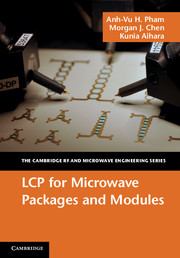Book contents
- Frontmatter
- Contents
- Preface
- 1 Introduction to electronic package engineering
- 2 Characteristics of liquid crystal polymer (LCP)
- 3 Fabrication techniques for processing LCP
- 4 LCP for wafer-level chip-scale MEMS
- 5 LCP for surface mount interconnects, packages, and modules
- 6 LCP for passive components
- 7 LCP for system design
- 8 LCP reliability
- Abbreviations, acronyms, and symbols
- Index
- References
7 - LCP for system design
Published online by Cambridge University Press: 05 July 2012
- Frontmatter
- Contents
- Preface
- 1 Introduction to electronic package engineering
- 2 Characteristics of liquid crystal polymer (LCP)
- 3 Fabrication techniques for processing LCP
- 4 LCP for wafer-level chip-scale MEMS
- 5 LCP for surface mount interconnects, packages, and modules
- 6 LCP for passive components
- 7 LCP for system design
- 8 LCP reliability
- Abbreviations, acronyms, and symbols
- Index
- References
Summary
This chapter presents a number of subsystem-level modules that benefit from an LCP implementation. The first module, in section 7.1, is a long time delay (LTD) circuit with amplitude compensation. This module demonstrates the advantages of homogenous dielectric core and ply layers in a multilayer build. Known analytic solutions for transmission lines may be readily applied for first-pass success. In addition, the homogenous multilayer build achieves amplitude compensation through novel LCP transmission line implementations. Lastly, this module demonstrates LCP’s surface mount (SMT) component compatibility with commercially available MEMS switches.
The second module, in section 7.2, is a push–pull amplifier. This module demonstrates how LCP’s multilayer construction easily allows minimally short bondwires for high-performance chip interconnect. Further, this module integrates high-performance LCP baluns to achieve excellent even-mode distortion cancellation. This module also demonstrates how LCP lends itself naturally to the higher-level integration of LCP-enhanced passives.
Lastly, a receiver module with a built-in phased-array antenna is described in section 7.3 . In this receiver module , LCP is demonstrated to provide a convenient platform for mechanically flexible electronics. Passive antenna structures are designed directly into the LCP build. Active semiconductor chips are packaged into this platform to show how LCP is ideally suited for building up large systems.
Each module represents advanced research based on an LCP platform that extends the electrical performance and mechanical functionality of today’s subsystem modules.
- Type
- Chapter
- Information
- LCP for Microwave Packages and Modules , pp. 193 - 225Publisher: Cambridge University PressPrint publication year: 2012



